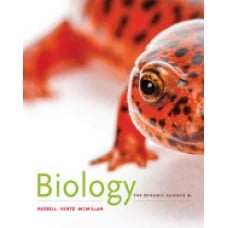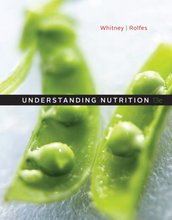Instant download Solution Manual for Biology The Dynamic Science, 4th Edition pdf docx epub after payment.

Product details:
- ISBN-10 : 9781305389892
- ISBN-13 : 978-1305389892
- Author: Beverly McMillan; Peter J. Russell; Paul E. Hertz
Russell/Hertz/McMillan, BIOLOGY: THE DYNAMIC SCIENCE 4e and MindTap teach Biology the way scientists practice it by emphasizing and applying science as a process. You learn not only what scientists know, but how they know it, and what they still need to learn. The authors explain complex ideas clearly and describe how biologists collect and interpret evidence to test hypotheses about the living world. Throughout, Russell and MindTap provide engaging applications, develop quantitative analysis and mathematical reasoning skills, and build conceptual understanding.
Table of contents:
- Contents
- Ch 1: Introduction to Biological Concepts and Research
- 1.1: What is Life? Characteristics of Living Organisms
- 1.2: Biological Evolution
- 1.3: Biodiversity and the Tree of Life
- 1.4: Biological Research
- Review Key Concepts
- Test Your Knowledge
- Ch 2: Life, Chemistry, and Water
- 2.1: The Organization of Matter: Elements and Atoms
- 2.2: Atomic Structure
- 2.3: Chemical Bonds and Chemical Reactions
- 2.4: Hydrogen Bonds and the Properties of Water
- 2.5: Water Ionization and Acids, Bases, and Buffers
- Review Key Concepts
- Test Your Knowledge
- Ch 3: Biological Molecules: The Carbon Compounds of Life
- 3.1: Formation and Modification of Biological Molecules
- 3.2: Carbohydrates
- 3.3: Lipids
- 3.4: Proteins
- 3.5: Nucleotides and Nucleic Acids
- Review Key Concepts
- Test Your Knowledge
- Ch 4: Cells
- 4.1: Basic Features of Cell Structure and Function
- 4.2: Prokaryotic Cells
- 4.3: Eukaryotic Cells
- 4.4: Specialized Structures of Plant Cells
- 4.5: The Animal Cell Surface
- Review Key Concepts
- Test Your Knowledge
- Ch 5: Membranes and Transport
- 5.1: Membrane Structure and Function
- 5.2: Functions of Membranes in Transport: Passive Transport
- 5.3: Passive Water Transport and Osmosis
- 5.4: Active Transport
- 5.5: Exocytosis and Endocytosis
- Review Key Concepts
- Test Your Knowledge
- Ch 6: Energy, Enzymes, and Biological Reactions
- 6.1: Energy, Life, and the Laws of Thermodynamics
- 6.2: Free Energy and Spontaneous Reactions
- 6.3: Adenosine Triphosphate (ATP): The Energy Currency of the Cell
- 6.4: Role of Enzymes in Biological Reactions
- 6.5: Conditions and Factors That Affect Enzyme Activity
- 6.6: RNA-Based Biological Catalysts: Ribozymes
- Review Key Concepts
- Test Your Knowledge
- Ch 7: Cellular Respiration: Harvesting Chemical Energy
- 7.1: Overview of Cellular Respiration
- 7.2: Glycolysis: Splitting the Sugar in Half
- 7.3: Pyruvate Oxidation and the Citric Acid Cycle
- 7.4: Oxidative Phosphorylation: The Electron Transfer System and Chemiosmosis
- 7.5: Anaerobic Respiration and Fermentation
- 7.6: Interrelationships of Catabolic and Anabolic Pathways
- Review Key Concepts
- Test Your Knowledge
- Ch 8: Photosynthesis
- 8.1: Photosynthesis: An Overview
- 8.2: The Light-Dependent Reactions of Photosynthesis
- 8.3: The Light-Independent Reactions of Photosynthesis
- 8.4: Photorespiration and Alternative Processes of Carbon Fixation
- 8.5: Photosynthesis and Cellular Respiration Compared
- Review Key Concepts
- Test Your Knowledge
- Ch 9: Cell Communication
- 9.1: Cell Communication: An Overview
- 9.2: Cell Communication Systems with Surface Receptors
- 9.3: Signaling Pathways Triggered by Surface Receptors
- 9.4: Signaling Pathways Triggered by Internal Receptors
- 9.5: Integration of Cell Communication Pathways
- Review Key Concepts
- Test Your Knowledge
- Ch 10: Cell Division and Mitosis
- 10.1: The Cycle of Cell Growth and Division: An Overview
- 10.2: The Mitotic Cell Cycle
- 10.3: Formation and Action of the Mitotic Spindle
- 10.4: Cell Cycle Regulation
- 10.5: Cell Division in Bacteria
- Review Key Concepts
- Test Your Knowledge
- Ch 11: Meiosis: The Cellular Basis of Sexual Reproduction
- 11.1: The Mechanisms of Meiosis
- 11.2: Mechanisms That Generate Genetic Variability
- 11.3: The Time and Place of Meiosis in Organismal Life Cycles
- Review Key Concepts
- Test Your Knowledge
- Ch 12: Mendel, Genes, and Inheritance
- 12.1: The Beginnings of Genetics: Mendel’s Garden Peas
- 12.2: Later Modifications and Additions to Mendel’s Principles
- Review Key Concepts
- Test Your Knowledge
- Ch 13: Genes, Chromosomes, and Human Genetics
- 13.1: Genetic Linkage and Recombination
- 13.2: Sex-Linked Genes
- 13.3: Chromosomal Mutations That Affect Inheritance
- 13.4: Human Genetic Traits, Pedigree Analysis, and Genetic Counseling
- 13.5: Non-Mendelian Patterns of Inheritance
- Review Key Concepts
- Test Your Knowledge
- Ch 14: DNA Structure and Replication
- 14.1: Establishing DNA as the Hereditary Molecule
- 14.2: DNA Structure
- 14.3: DNA Replication
- 14.4: Repair of Errors in DNA
- Review Key Concepts
- Test Your Knowledge
- Ch 15: From DNA to Protein
- 15.1: The Connection between DNA, RNA, and Protein
- 15.2: Transcription: DNA-Directed RNA Synthesis
- 15.3: Production of mRNAs in Eukaryotes
- 15.4: Translation: mRNA-Directed Polypeptide Synthesis
- 15.5: Genetic Changes That Affect Protein Structure and Function
- Review Key Concepts
- Test Your Knowledge
- Ch 16: Regulation of Gene Expression
- 16.1: Regulation of Gene Expression in Prokaryotes
- 16.2: Regulation of Transcription in Eukaryotes
- 16.3: Posttranscriptional, Translational, and Posttranslational Regulation
- 16.4: Genetic and Molecular Regulation of Development
- 16.5: The Genetics and Genomics of Cancer
- Review Key Concepts
- Test Your Knowledge
- Ch 17: Bacterial and Viral Genetics
- 17.1: Gene Transfer and Genetic Recombination in Bacteria
- 17.2: Viruses and Viral Genetics
- 17.3: Viroids and Prions, Infectious Agents Lacking Protein Coats
- Review Key Concepts
- Test Your Knowledge
- Ch 18: DNA Technologies: Making and Using Genetically Altered Organisms, and Other Applications
- 18.1: Key DNA Technologies for Making Genetically Altered Organisms
- 18.2: Applications of Genetically Altered Organisms
- 18.3: Other Applications of DNA Technologies
- Review Key Concepts
- Test Your Knowledge
- Ch 19: Genomes and Proteomes
- 19.1: Genomics: An Overview
- 19.2: Genome Sequence Determination and Annotation
- 19.3: Determining the Functions of the Genes in a Genome
- 19.4: Genome Evolution
- Review Key Concepts
- Test Your Knowledge
- Ch 20: Development of Evolutionary Thinking
- 20.1: Recognition of Evolutionary Change
- 20.2: Darwin’s Journeys
- 20.3: Evolutionary Biology since Darwin
- Review Key Concepts
- Test Your Knowledge
- Ch 21: Microevolution: Genetic Changes within Populations
- 21.1: Variation in Natural Populations
- 21.2: Population Genetics
- 21.3: The Agents of Microevolution
- 21.4: Maintaining Genetic and Phenotypic Variation
- 21.5: Adaptation and Evolutionary Constraints
- Review Key Concepts
- Test Your Knowledge
- Ch 22: Speciation
- 22.1: What is a Species?
- 22.2: Maintaining Reproductive Isolation
- 22.3: The Geography of Speciation
- 22.4: Genetic Mechanisms of Speciation
- Review Key Concepts
- Test Your Knowledge
- Ch 23: Paleobiology and Macroevolution
- 23.1: The Fossil Record
- 23.2: Earth History
- 23.3: Historical Biogeography and Convergent Biotas
- 23.4: The History of Biodiversity
- 23.5: Interpreting Evolutionary Lineages
- 23.6: The Evolution of Morphological Novelties
- Review Key Concepts
- Test Your Knowledge
- Ch 24: Systematics and Phylogenetics: Revealing the Tree of Life
- 24.1: Nomenclature and Classification
- 24.2: Phylogenetic Trees
- 24.3: Sources of Data for Phylogenetic Analyses
- 24.4: Traditional Classification and Paraphyletic Groups
- 24.5: The Cladistic Revolution
- 24.6: Phylogenetic Trees as Research Tools
- 24.7: Molecular Phylogenetic Analyses
- Review Key Concepts
- Test Your Knowledge
- Ch 25: The Origin of Life
- 25.1: The Formation of Molecules Necessary for Life
- 25.2: The Origin of Cells
- 25.3: The Origins of Eukaryotic Cells
- Review Key Concepts
- Test Your Knowledge
- Ch 26: Prokaryotes: Bacteria and Archaea
- 26.1: Prokaryotic Structure and Function
- 26.2: The Domain Bacteria
- 26.3: The Domain Archaea
- Review Key Concepts
- Test Your Knowledge
- Ch 27: Protists
- 27.1: What is a Protist?
- 27.2: The Protist Groups
- Review Key Concepts
- Test Your Knowledge
- Ch 28: Seedless Plants
- 28.1: Plant Evolution: Adaptations to Life on Land
- 28.2: Bryophytes, the Nonvascular Land Plants
- 28.3: Seedless Vascular Plants
- 28.4: Ecological, Economic, and Research Importance of Seedless Plants
- Review Key Concepts
- Test Your Knowledge
- Ch 29: Seed Plants
- 29.1: The Rise of Seed Plants
- 29.2: Gymnosperms: The “Naked Seed” Plants
- 29.3: Angiosperms: Flowering Plants
- 29.4: Insights from Plant Genome Research
- 29.5: Seed Plants and People
- Review Key Concepts
- Test Your Knowledge
- Ch 30: Fungi
- 30.1: General Characteristics of Fungi
- 30.2: Evolution of the Kingdom Fungi
- 30.3: Fungal Associations: Lichens and Mycorrhizae
- 30.4: Impacts of Fungi in Ecosystems and Society
- Review Key Concepts
- Test Your Knowledge
- Ch 31: Animal Phylogeny, Acoelomates, and Protostomes
- 31.1: What is an Animal?
- 31.2: Key Innovations in Animal Evolution
- 31.3: An Overview of Animal Phylogeny and Classification
- 31.4: Animals without Tissues: Parazoa
- 31.5: Eumetazoans with Radial Symmetry
- 31.6: Lophotrochozoan Protostomes
- 31.7: Ecdysozoan Protostomes
- Review Key Concepts
- Test Your Knowledge
- Ch 32: Deuterostomes: Vertebrates and Their Closest Relatives
- 32.1: Invertebrate Deuterostomes
- 32.2: Overview of the Phylum Chordata
- 32.3: The Origin and Diversification of Vertebrates
- 32.4: “Agnathans”: Hagfishes and Lampreys, Conodonts and Ostracoderms
- 32.5: Gnathostomata: The Evolution of Jaws
- 32.6: Tetrapoda: The Evolution of Limbs
- 32.7: Amniota: The Evolution of Fully Terrestrial Vertebrates
- 32.8: Living Lepidosaurs: Sphenodontids and Squamates
- 32.9: Living Archelosaurs: Turtles, Corocodilians, and Birds
- 32.10: Mammalia: Monotremes, Marsupials, and Placentals
- 32.11: Nonhuman Primates
- 32.12: The Evolution of Humans
- Review Key Concepts
- Test Your Knowledge
- Ch 33: The Plant Body
- 33.1: Basic Concepts of Plant Structure and Growth
- 33.2: The Three Plant Tissue Systems
- 33.3: Root Systems
- 33.4: Primary Shoot Systems
- 33.5: Secondary Growth
- Review Key Concepts
- Test Your Knowledge
- Ch 34: Transport in Plants
- 34.1: Overview of Water and Solute Movements in Plants
- 34.2: Roots: Moving Water and Minerals into the Plant
- 34.3: Transport of Water and Minerals in the Xylem
- 34.4: Stomata: Regulating the Loss of Water by Transpiration
- 34.5: Transport of Organic Substances in the Phloem
- Review Key Concepts
- Test Your Knowledge
- Ch 35: Plant Nutrition
- 35.1: Plant Nutritional Requirements
- 35.2: Soil
- 35.3: Root Adaptations for Obtaining and Absorbing Nutrients
- Review Key Concepts
- Test Your Knowledge
- Ch 36: Reproduction and Development in Flowering Plants
- 36.1: Overview of Flowering Plant Reproduction
- 36.2: The Formation of Flowers and Gametes
- 36.3: Pollination, Fertilization, and Germination
- 36.4: Asexual Reproduction of Flowering Plants
- 36.5: Early Plant Development
- Review Key Concepts
- Test Your Knowledge
- Ch 37: Plant Signals and Responses to the Environment
- 37.1: Introduction to Plant Hormones
- 37.2: Plant Chemical Defenses
- 37.3: Plant Movements
- 37.4: Plant Biological Clocks
- Review Key Concepts
- Test Your Knowledge
- Ch 38: Introduction to Animal Organization and Physiology
- 38.1: Organization of the Animal Body
- 38.2: Animal Tissues
- 38.3: Coordination of Tissues in Organs and Organ Systems
- 38.4: Homeostasis
- Review Key Concepts
- Test Your Knowledge
- Ch 39: Information Flow and the Neuron
- 39.1: Neurons and Their Organization in Nervous Systems
- 39.2: Signaling by Neurons
- 39.3: Transmission across Chemical Synapses
- 39.4: Integration of Incoming Signals by Neurons
- Review Key Concepts
- Test Your Knowledge
- Ch 40: Nervous Systems
- 40.1: Invertebrate and Vertebrate Nervous Systems Compared
- 40.2: The Peripheral Nervous System
- 40.3: The Central Nervous System and Its Functions
- 40.4: Memory, Learning, and Consciousness
- Review Key Concepts
- Test Your Knowledge
- Ch 41: Sensory Systems
- 41.1: Overview of Sensory Receptors and Pathways
- 41.2: Mechanoreceptors and the Tactile and Spatial Senses
- 41.3: Mechanoreceptors and Hearing
- 41.4: Photoreceptors and Vision
- 41.5: Chemoreceptors
- 41.6: Thermoreceptors and Nociceptors
- 41.7: Magnetoreceptors and Electroreceptors
- Review Key Concepts
- Test Your Knowledge
- Ch 42: The Endocrine System
- 42.1: Hormones and Their Secretion
- 42.2: Mechanisms of Hormone Action
- 42.3: The Hypothalamus and Pituitary
- 42.4: Other Major Endocrine Glands of Vertebrates
- 42.5: Endocrine Systems in Invertebrates
- Review Key Concepts
- Test Your Knowledge
- Ch 43: Muscles, Bones, and Body Movements
- 43.1: Vertebrate Skeletal Muscle: Structure and Function
- 43.2: Skeletal Systems
- 43.3: Vertebrate Movement: The Interactions between Muscles and Bones
- Review Key Concepts
- Test Your Knowledge
- Ch 44: The Circulatory System
- 44.1: Animal Circulatory Systems: An Introduction
- 44.2: Blood and Its Components
- 44.3: The Heart
- 44.4: Blood Vessels of the Circulatory System
- 44.5: Maintaining Blood Flow and Pressure
- 44.6: The Lymphatic System
- Review Key Concepts
- Test Your Knowledge
- Ch 45: Defenses against Disease
- 45.1: Three Lines of Defense against Pathogens
- 45.2: Innate Immunity: Nonspecific Defenses
- 45.3: Adaptive Immunity: Specific Defenses
- 45.4: Malfunctions and Failures of the Immune System
- 45.5: Evolved Defenses against Pathogens in Other Animals
- Review Key Concepts
- Test Your Knowledge
- Ch 46: Gas Exchange: The Respiratory System
- 46.1: The Function of Gas Exchange
- 46.2: Evolutionary Adaptations for Respiration
- 46.3: The Mammalian Respiratory System
- 46.4: Mechanisms of Gas Exchange and Transport
- 46.5: Respiration at High Altitudes and in Ocean Depths
- Review Key Concepts
- Test Your Knowledge
- Ch 47: Animal Nutrition
- 47.1: Feeding and Nutrition
- 47.2: Digestive Processes
- 47.3: Digestion in Humans and Other Mammals
- 47.4: Regulation of the Digestive Process
- 47.5: Digestive Specializations in Vertebrates
- Review Key Concepts
- Test Your Knowledge
- Ch 48: Regulating the Internal Environment
- 48.1: Introduction to Osmoregulation and Excretion
- 48.2: Osmoregulation and Excretion in Invertebrates
- 48.3: Osmoregulation and Excretion in Mammals
- 48.4: Regulation of Mammalian Kidney Function
- 48.5: Kidney Function in Nonmammalian Vertebrates
- 48.6: Introduction to Thermoregulation
- 48.7: Ectothermy
- 48.8: Endothermy
- Review Key Concepts
- Test Your Knowledge
- Ch 49: Animal Reproduction
- 49.1: Animal Reproductive Modes: Asexual and Sexual Reproduction
- 49.2: Cellular Mechanisms of Sexual Reproduction
- 49.3: Sexual Reproduction in Humans
- 49.4: Methods for Preventing Pregnancy: Contraception
- Review Key Concepts
- Test Your Knowledge
- Ch 50: Animal Development
- 50.1: Mechanisms of Embryonic Development
- 50.2: Major Patterns of Cleavage and Gastrulation
- 50.3: From Gastrulation to Adult Body Structures: Organogenesis
- 50.4: Embryonic Development of Humans and Other Mammals
- 50.5: The Cellular Basis of Development
- Review Key Concepts
- Test Your Knowledge
- Ch 51: Ecology and the Biosphere
- 51.1: The Science of Ecology
- 51.2: Environmental Diversity of the Biosphere
- 51.3: Organismal Responses to Environmental Variation and Climate Change
- 51.4: Terrestrial Biomes
- 51.5: Freshwater Environments
- 51.6: Marine Environments
- Review Key Concepts
- Test Your Knowledge
- Ch 52: Population Ecology
- 52.1: Population Characteristics
- 52.2: Demography
- 52.3: The Evolution of Life Histories
- 52.4: Models of Population Growth
- 52.5: Population Dynamics
- 52.6: Human Population Growth
- Review Key Concepts
- Test Your Knowledge
- Ch 53: Population Interactions and Community Ecology
- 53.1: Population Interactions
- 53.2: The Nature of Ecological Communities
- 53.3: Community Characteristics
- 53.4: Effects of Population Interactions of Community Characteristics
- 53.5: Effects of Disturbance on Community Characteristics
- 53.6: Ecological Succession: Responses to Disturbance
- 53.7: Variations in Species Richness among Communities
- Review Key Concepts
- Test Your Knowledge
- Ch 54: Ecosystems and Global Change
- 54.1: Modeling Ecosystem Processes
- 54.2: Energy Flow and Ecosystem Energetics
- 54.3: Nutrient Cycling in Ecosystems
- 54.4: Human Activities and Anthropogenic Global Change
- Review Key Concepts
- Test Your Knowledge
- Ch 55: Biodiversity and Conservation Biology
- 55.1: The Biodiversity Crisis on Land, in the Sea, and in River Systems
- 55.2: Specific Threats to Biodiversity
- 55.3: Ecosystem Services That Biodiversity Provides
- 55.4: Which Species and Ecosystems are Most Threatened by Human Activities?
- 55.5: Conservation Biology: Principles and Theory
- 55.6: Conservation Biology: Practical Strategies and Economic Tools
- Review Key Concepts
- Test Your Knowledge
- Ch 56: Animal Behavior
- 56.1: Instinctive and Learned Behaviors
- 56.2: Neurophysiological and Endocrine Control of Behavior
- 56.3: Migration and Wayfinding
- 56.4: Habitat Selection and Territoriality
- 56.5: The Evolution of Communication
- 56.6: The Evolution of Reproductive Behavior and Mating Systems
- 56.7: The Evolution of Social Behavior
- Review Key Concepts
- Test Your Knowledge
- Appendix A: Answers
- Appendix B: Classification System
- Glossary
- Index





